Discovering
Greater Earth

Arthur Woods
P.O. Box 180, CH- 8424 Embrach
1.0 Introduction
Since the beginning of human history the perception of its
home planet Earth has always influenced the way humanity has
formulated its beliefs and conducted
its affairs. When Earth was perceived of as the entire universe it gave rise
to myths and religions that permeate and influence society into the present
time. Recently, space exploration has provided humanity a perception of the "Whole
Earth" - a blue sphere floating in the vast expanses of the cosmos. This perception
has catalyzed the globalization of its cultures and defines many of its present
activities.
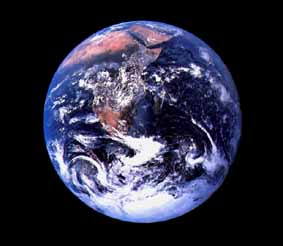
Figure.
1 . Earth as seen from Apollo 17
Today,
most people live with this perception of planet Earth as
seen in (Figure 1) . The famous photograph made by
the Apollo 17 astronauts on their way home from the Moon.
We are comfortable with this image of Earth as defined by
the edges of its atmosphere and it has become a powerful
symbol of our times representing the environmental movements,
the globalization of our diverse cultures and economies,
and the understanding the interdependence of our climate
and ecology . For most people there is no need to discuss
this perception. It is a 20th century view of Earth and most
people conduct their affairs accordingly. Not very different
than our early ancestors, we are convinced that whatever
humanity's fate in the years ahead, that fate will be decided
and enacted on this blue sphere.
However,
this perception of our home planet is outdated, constraining
and unnecessary. This paper introduces the need to formulate
a new perception of planet Earth based on its true dimensions
- a perception called Greater Earth (Wynn & Griffin,
1994). Within the boundaries of Greater Earth our species
will find the room, resources and opportunities it will need
to survive and prosper in the coming millennium.
2.0 The World is Getting Smaller
Earth
has always been the provider of raw materials and the mother
of Life. When humans were few Earth itself
was the frontier to be discovered and explored. As exploration
gave way to exploitation, the human species successfully
established its dominance over the rest of Nature and has
occupied the planet as no other species before it. It has
devised means to extract and utilize resources to feed its
populous and to power its development. It has occupied the
lands, farmed the vast oceans and traversed the skies in
its quest for perpetual progress and development.
The
phrase “The world is getting smaller” if
often used when speaking about faster, safer more efficient
modes of transportation. It is also applied to the comprehensive
communication technologies that can instantaneously connect
anyone with another from almost any point on the globe. For
all the positive and exciting benefits that these unprecedented
and fantastic aspects of modern life are providing us, we
all know that there an unsettling side to these developments.
First and foremost is the uncomfortable realization that
the world is not only getting smaller but it is also getting
more crowded.
“The
Limits to Growth” was the controversial book produced
by the Club of Rome that appeared in 1972 and which did
much to stimulate the discussion about the relationship
between resource depletion, the environmental consequences
of industrialization and population growth. Its conclusions
are still being debated today. Here is a quote from the
introduction to the book. (Meadows, Meadows, Randers, Behrens,
1972)
“WILL
THIS BE THE WORLD THAT
YOUR GRANDCHILDREN - WILL THANK YOU FOR?
A
world where industrial production has sunk to zero. Where
population has suffered a catastrophic decline. Where the
air, sea, and land are polluted beyond redemption. Where
civilization is a distant memory. This is the world that
the computer forecasts. What is even more alarming, the
collapse will not come gradually, but with awesome suddenness
, with no way of stopping it. This is the message and the
warning of The Limits to Growth, a book that may
well offer mankind's last chance for survival. “
Now
the university computer that the Club of Rome used was
probably not as powerful as the one I use in my office, and
their
modeling program was not as good as those that have been
developed since, but anyone with common sense would agree
that there is only enough physical room and resources on
our blue sphere for “x” number of people to live
with some degree of comfort. The question of course is: “How
many people?”
A
quick look at history puts human population growth into some
perspective. Just 10,000 years ago there were only about
5 million people on the planet living, at that time, mostly
in caves. For these people planet Earth was surely the entire
cosmos. 8,000 years later, there were 130 million people
around when Christianity was born. By 1650 the human population
grew to about 500 million. 200 years later, at the beginning
of the industrial age, it doubled to 1 billion. Our planet
still seemed large enough and resilient enough to support
any human purpose. 100 years later, around 1950, the number
of humans increased to 2.5 billion. The chart below indicates
that this number has more than doubled since then. All of
these statistics are alarming but for the purposes of this
paper I will refer to just the world population figures and
the estimates concerning crude oil.
Concerning,
population, we are currently adding about 1 million people
to the total population every 5 days which means that there
will be more than 6 billion people on Earth in just about
one year.
This
chart and the text below it are from the Millennium Institute’s
Website. http://www.igc.apc.org/millennium/index.html
These
figures called “State of Our World Indicators” were
posted on March 9, 1998.
- World
Population: 5,901,285,756
- Increase
Per Day: 217,467
- Years
Until Insufficient Land - Northern Diet: 7
- Years
Until Insufficient Land - Southern Diet: 38
- Species
Extinctions Per Day: 104
- Years
Until 1/3 Of Species Are Lost: 8
- Years
Until Half of Crude Oil Is Gone: 2
- Years
Until 80% of Crude Oil Is Gone: 22
- Percent
Antarctic Ozone Depletion: 70+
- Carbon
Dioxide, Years Until Doubling: 59
- Water
Availability (000 cubic meters/person/year): 10 (estimate)
“The
rate of world population increase in 1995 was around 88,000,000
per year, or 215,847 per day. The current rate of natural
increase is approximately 217,467 per day. If fertility
and mortality had remained constant at 1990 levels we would
reach 12 billion people in 2028. Current projections say
it will take a little longer. The U.S. Census Bureau projects
a world population of about 9.4 billion in 2050. Twelve
billion is the maximum population that some experts think
Earth can sustain. Others, like Gretchen Daily, Paul Ehrlich,
and Anne Ehrlich calculate that Earth can only support
1.5 to 2 billion people at a sustainable, decent standard
of living. At the very least humanity needs to act to prevent
population growth from exceeding 12 billion people. Population
growth has momentum, however. Even if we had somehow instantaneously
achieved "replacement" fertility in 1990, the population
would still ultimately increase to 8.35 billion due to
the younger portion of the population reaching childbearing
age. We have a very short period of time in which to reduce
population growth.”
Original Source: United Nations. 1992. Long-Range World Population Projections:
Two Centuries of Population Growth, 1950-2150. New York: United Nations
The positive side of having so many people on Earth is that humanity has never
experienced so much creativity and progress in such a short time. Humanity
itself must be considered as its most valuable resource and its challenge
is to find suitable ways to feed, clothe and otherwise nourish this resource
in a comfortable and prosperous manner.
The
most important resource in this respect is energy and most
of modern society is powered by refined crude oil. The first
chart below (Figure 3) indicates the amount of crude
oil still in the ground in the year 1900 and the next chart (Figure
4) estimates the amount which will be remaining in the
year 2010. The chart above indicates that we have 2 years
until half of Earth’s crude oil supplies are gone and
22 years until 80% of this resource is used up.

Figure 3. Petroleum Reserves in 1900
Source: Masters, C. D.; Root, D. H.; and Attanasi, E. D.
1991. "Resource Constraints
in Petroleum Production Potential." Science. vol. 253. 12 July 1991. pp. 146-152.
The pessimists will say that our civilization’s oil tank
is already half empty, the optimists will counter that the
tank is still half full. In any
case, the amount of crude oil in the ground is finite and given the increase
in population and in the overall standard of living, we will be using the remaining
amounts of oil rather faster than slower. Knowing these figures, one must surely
question multi-billion dollar investments in new airports. Solar powered airplanes
that can carry hundreds of passengers around the world has yet to be invented.

Figure
4 . Remaining Petroleum Reserves Year 2010
Source:
Masters, C. D.; Root, D. H.; and Attanasi, E. D. 1991. "Resource
Constraints in Petroleum Production Potential." Science.
vol. 253. 12 July 1991. pp. 146-152.
.
Figure
5. Energy Input for farming corn.
Source:
Pimentel, D. and Wen, D. Technological Changes in Energy
Use in U.S. Agricultural Production. In: Carrol, C. R.;
Vandermeer, J. H.; and Rosset, P. M. 1990. Agroecology.
New York: McGraw-Hill Publishing Company. p. 152.
While
we may be able to convince ourselves to give up our cars,
jet airplanes and a vast number of consumer goods, (Figure
5) indicates that we also need to use more and more energy
just to feed all those new hungry human beings. In any case
energy is the essential resource driving humanity’s
economy , its society and its future development. Our major
source of energy today is oil and it is no longer a question
of “if” we will run out of oil, but “when”.
So in order to avoid the prognosis and the consequences of
the Club of Rome forecasts, terrestrial solutions to the
above situation can be generalized in the following three
options:
- Reduce
world population to 1.5 - 2 billion people.The ethical
question is “how”.
- Turn
off our economy , reduce our standard of living and let
nature take its course.
- Discover
a new source of energy and invent new technologies that
will solve the problem.
The
first two options are not very optimistic scenarios for the
8-12 billion people that we will see in the next twenty to
fifty years. The last option is what most people are hoping
for - our faith is always in ourselves and in our resourcefulness.
Yet, every form of terrestrial energy production known to
us today is either hopelessly inefficient or poses a serious
danger to the environment. None can sustain a population
of 8 billion or more humans with a standard of living that
most people in the industrialized nations are used to - and
those who are not - aspire to.
As
the twenty-first century begins, humanity finds that it needs
more room and more resources to sustain its numbers and to
maintain its thirst for development. The resources that contributed
to its present state are being irrevocably deplenished to
unsustainable levels and their uncontrolled use within the
biosphere is resulting in severe ecological consequences.
What is needed is a bigger, richer planet, one with more
room and more resources for all those creative and busy brothers
and sisters we will be meeting in the years ahead. While
this idea may sound a bit far-fetched and unrealistic, it
is indeed what I want to offer you in the remainder of this
presentation. As it has done done throughout its history,
to meet the needs and the challenges of the future in a humane
way, it is time for humanity to change its perception of
its planet once again.
3.0 Welcome to Greater Earth
In
the mid twentieth century humans began to investigate ways
to penetrate the atmosphere. Today a communications apparatus
installed beyond the atmosphere permits us to remain in constant
touch with each other from any place on the planet. Orbital
outposts are providing the information to enable human beings
to adapt to this new environment. Scientific instruments
placed in this area are exploring the depths of the cosmos
and investigating the state of the environment below. In
a short time these activities have effectively expanded the
territory of planet Earth from its solid dimensions of 12,
756 kilometers to a diameter of more than 85,000 kilometers.
This distance represents the orbital ring of geosynchronous
satellites.
All
celestial bodies of significant concentrated mass exert a
field of gravity around their cores which extends to a point
where the competing forces of gravity are neutralized. Earth's
gravitational field extends 1.495.000 kilometers from its
center where it meets the gravitational influence of the
Sun. This sphere has 13 million times the volume of the physical
Earth and through it, passes some 30,000 times the amount
of solar power which is available on the surface. Within
this sphere of 3 million kilometers are enormous amounts
of other resources, including the Moon and occasional passing
asteroids. Like the territorial waters surrounding nations
- these resources belong to our planet and should be used
for the ultimate benefit of all Life which has originated
there. (Woods & Bernasconi, 1995)

Figure
6. Gravitational Influence of the Sun and Earth

Figure
7. View of Greater Earth from its Perimeter.
The
chart (Figure 6) describes the relation of the gravitational
spheres of influence between the Earth and the Sun. The one
below it, (Figure 7) is
a view of the planet as seen from the edge of Greater Earth. Here , Earth would
appear to one’s field of vision to be about a s large as the Moon appears
in our night sky.
4.0 The Resources of Greater Earth
Here
is a brief overview of some of the resources that we can
expect to find in Greater Earth. First and foremost, is an
inexhaustible supply of clean solar energy. Basically stated,
this energy can be captured by photovoltaics, converted into
electricity and beamed via microwaves to the receiving antennas
located in unpopulated areas on the surface of Earth. A Solar
Power Station could be located in orbit like this Japanese
concept called SPS 2000 (Figure 8).

Figure
8. SPS 2000
More
practical and economical may be to build them on the Moon
itself as pictured in the illustration of David Criswell’s
Lunar Power System seen below (Figure 9 ).

Figure
9. Lunar Power System
In
either case, an unlimited supply of clean solar energy could
meet humanity’s growing energy requirements in the years
ahead. Not only would we have enough electricity to power
our industries, but we would have the necessary energy to
break water down into its hydrogen and oxygen components
and to use the hydrogen as fuel for our cars, trucks and
tractors insuring personal mobility and and farming.
With
a plentiful source of energy located outside of the atmosphere
we may then consider placing our most polluting terrestrial
industries outside of the biosphere making our terrestrial
home a more pleasant place to live and raise our children.
For this to happen we would need a good source of raw materials.
The next chart (Figure 10) shows the composition of
lunar soil and the materials located there. The recent discovery
of water on the Moon adds to these significantly as this
could supply a colony of 2000 people with enough water to
last through the next century - a considerable savings if
we had to transport this water from the Earth to Moon.
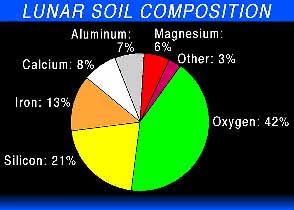
Figure
10. Composition of Lunar Soil
We would expect new industries to flourish as the economies of Greater Earth
catch on. The idea of harvesting Helium 3, which is plentiful in lunar
soil to be used in nuclear fusion reactors back on Earth has been proposed.
Tourism would be another economic development of an expanded human presence
beyond the atmosphere of the home planet. For this to happen we will have
to have reliable reusable launchers and spacecraft, which will permit travel
throughout the new territories of Greater Earth with the regularity of
today’s airline traffic. (Figure 9) shows a Lunar Oxygen factory also
necessary to support human and industrial operations on the Moon as well
as rocket fuel for other activities. As the economy develops further humanity
my be attracted to inhabiting the new territory of Greater Earth by building
gravitationally stabilized orbiting hotels or communities. The one pictured
in (Figure 10) is self supporting with vegetable gardens and fish
farms. As these new industries and economies mature, the products, technologies,
resources, skills and knowledge obtained would be used to keep our terrestrial
Earth a pleasant and healthy place to live and play.
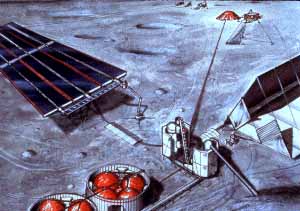
Figure
11. Lunar Oxygen Plant
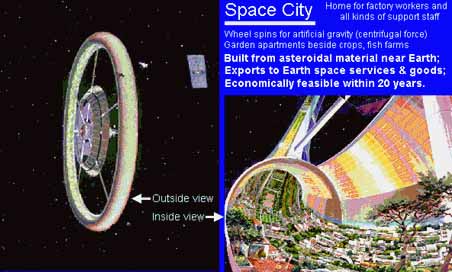
Figure
12. Orbital City
Recently,
astronomer Jim Scotti was in the news with his discovery
of asteroid 1997 XF11 that is headed for the vicinity of
Earth in the year 2028. His first calculations indicated
that this 1.6 kilometer wide rock would pass the Earth somewhat
less than the distance of the Moon. Although more data and
a recalculation show that this distance will now be more
than 600,000 miles, this scare has made humanity more sensitive
to the vulnerability of its planet to the ecology of the
cosmos. Not long ago we witnessed the comet Shoemaker -Levy
leave scars on Jupiter that were larger than the Earth itself.
By developing an infrastructure in the territory of Greater
Earth we can turn a cosmic catastrophe as portrayed by artist
Don Davis ( Figure 13) into a commercial opportunity
as illustrated by the painting by David Hardy (Figure
14).

Figure
13. Comet Impact - Painting by Don Davis
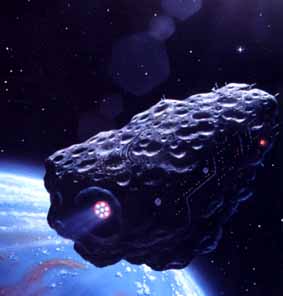
Figure
14. Asteroid Habitat. Painting by David Hardy
6.0 Conclusions
This
has been just a brief introduction to Greater Earth. The
advantages of adopting this new perspective of our planet
are substantial. They include:
- Access
to vital resources necessary to meet the growing needs
of humanity, especially a source of unlimited clean solar
energy.
- A
heat and pollution sink for moving industries outside of
the biosphere.
- Creating
an infrastructure beyond the atmosphere may help provide
a defense from possible impacts by asteroids and comets
- A
new territory for human endeavors leading to new knowledge,
skills and technology.
- The
possibility to create an optimistic and prosperous future
for future generations.
- Developing
Greater Earth opens the door to the Solar System exploration
and development.
As
human creativity and diversity multiply new ideas and even
new cultures may emerge as they did in other older, frontiers.
To survive and to prosper in the new millennium the next
step for our species is to exercise its fullest capabilities
to occupy and enjoy this new territory that is part of its
cosmic home. By doing so wisely, it may survive and thrive
and go on to other places and adventures. Greater Earth is
the gateway to the Solar System.
7.0 References and Figures
- Figure
1. Earth Photograph Apollo 17, NASA
- Wynn,
E.G. and Griffin, K., It’s Greater Earth, Stupid,
Commentary published in Space News March 21, 1994.
- Woods,
A.R. and Bernasconi, M. C., Choosing A Space Age Or A Stone
Age, Commentary published in Space News, October 2, 1995.
- Meadows,
D. H., Meadows, D.L., Randers, J. , Behrens III , W. W.
, (1972) The Limits to Growth, Signet Non-Fiction, New
York. pp. i.
- Figures
3, 4, & 5. Website: The Millennium Institute, http://www.igc.apc.org/millennium/index.html,
State of Our World Indicators
- Figure
7. NASA: Website: A Space Library, Solar System Simulator,
http://samadhi.jpl.nasa.gov/
- Figure
8. Glaser, P., The Driver For Space Activities, Ad Astra,
NSS, Nov. Dec. 1996, pp. 30
- Figure
9. Criswell, D. & Harris, P., An Alternative Solar
Energy Source, Earth Space Review, Vol2. No.2, 1993, pp.
11.
- Figure
10, 11 & 12. Prado, M., Website: P.E.R.M.A.N.E.N.T.
, http://www.permanent.com
- Figure
13. Sagan, C., (1994) A Pale Blue Dot, pp. 308. Impact
of Comet on Earth, A painting by Don Davis, Random House,
New York
- Figure
14.Sagan, C., (1994) A Pale Blue Dot,pp. 378. Inhabited
Asteroid, A painting by David Hardy, Random House, New
York,
Copyright © 1998
Arthur Woods
|

